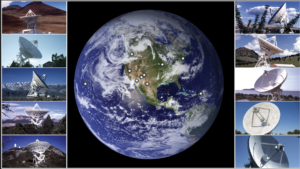The largest astronomical array in North America is one step closer to becoming a reality. The National Radio Astronomy Observatory (NRAO) is pleased to announce that the National Science Foundation (NSF) has awarded a 3-year, $21 million grant to Associated Universities, Inc. (AUI) to further the design of the next generation Very Large Array (ngVLA). Said Tony Beasley, Director of NRAO, “Despite challenging economic times, this award demonstrates a strong commitment from the research community and the NSF to create astronomy’s next great instrument, and continue U.S. radio astronomy leadership. NRAO is committed to begin construction of the ngVLA later this decade.”
Late this summer, the NSF formally entered the ngVLA project into the Major Research Equipment and Facilities Construction (MREFC) design process at the Conceptual Design Phase. The NSF-led Conceptual Design Review (CDR) is expected next Spring and will be supported by this most recent award. While this does not yet represent a commitment to construct the telescope, the review signals the project’s strong scientific and technical promise and growing project readiness. The three MREFC reviews (Conceptual, Preliminary, and Final) will provide NSF with the critical information needed to consider adding ngVLA construction to a budget request later this decade.
The concept for the ngVLA was created in 2016, and the telescope was presented to the ASTRO2020 Decadal Survey in 2019. Delivery of the ngVLA prototype antenna to the VLA site is expected in summer 2024.
Learn more about the ngVLA https://ngvla.nrao.edu/
The National Radio Astronomy Observatory is a facility of the National Science Foundation, operated under a cooperative agreement by Associated Universities, Inc.
The post $21 Million NSF Award Will Bring ngVLA Design to Life appeared first on National Radio Astronomy Observatory.













